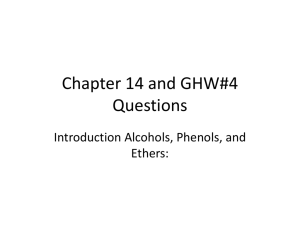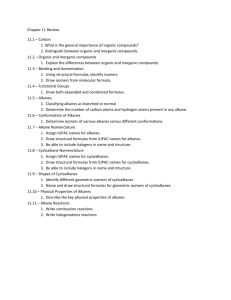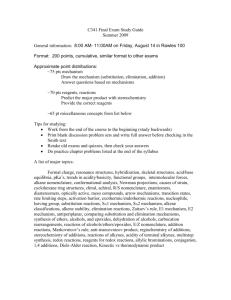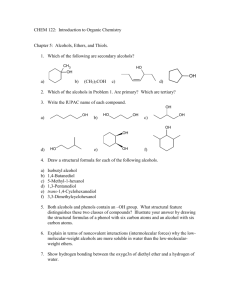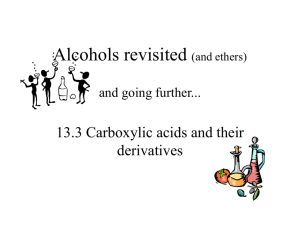GHW#4-Questions&slides
advertisement
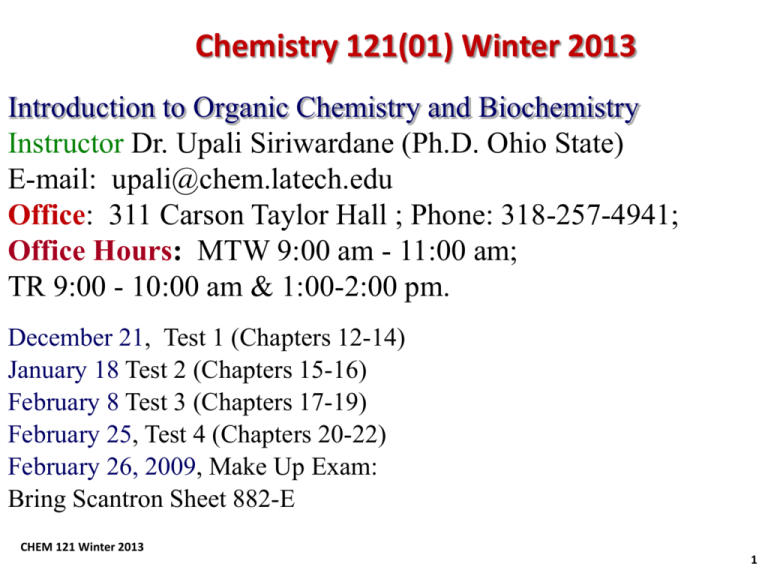
Chemistry 121(01) Winter 2013 Introduction to Organic Chemistry and Biochemistry Instructor Dr. Upali Siriwardane (Ph.D. Ohio State) E-mail: upali@chem.latech.edu Office: 311 Carson Taylor Hall ; Phone: 318-257-4941; Office Hours: MTW 9:00 am - 11:00 am; TR 9:00 - 10:00 am & 1:00-2:00 pm. December 21, Test 1 (Chapters 12-14) January 18 Test 2 (Chapters 15-16) February 8 Test 3 (Chapters 17-19) February 25, Test 4 (Chapters 20-22) February 26, 2009, Make Up Exam: Bring Scantron Sheet 882-E CHEM 121 Winter 2013 1 Chapter 14 and GHW#4 Questions Introduction Alcohols, Phenols, and Ethers: Chapter 12. Saturated Hydrocarbons 12.1 Organic and Inorganic Compounds, 341 12.2 Bonding Characteristics of the Carbon Atom, 342 12.3 Hydrocarbons and Hydrocarbon Derivatives, 342 12.4 Alkanes: Acyclic Saturated Hydrocarbons, 343 12.5 Structural Formulas, 344 12.6 Alkane Isomerism, 346 12.7 Conformations of Alkanes, 348 12.8 IUPAC Nomenclature for Alkanes, 350 12.9 Line-Angle Structural Formulas for Alkanes, 356 12.10 Classification of Carbon Atoms, 358 12.11 Branched-Chain Alkyl Groups, 359 12.12 Cycloalkanes, 361 12.13 IUPAC Nomenclature for Cycloalkanes, 362 12.14 Isomerism in Cycloalkanes, 363 12.15 Sources of Alkanes and Cycloalkanes, 365 12.16 Physical Properties of Alkanes and Cycloalkanes, 367 12.17 Chemical Properties of Alkanes and Cycloalkanes, 368 12.18 Halogenated Alkanes and Cycloalkanes, 371 1. Bonding Characteristics of Oxygen Atoms in Organic Compounds Structural Characteristics of Alcohols 1. Identify the Alcohols, Phenols, and Ethers from the following and give their common and/or IUPAC names. 1. Identify the Alcohols, Phenols, and Ethers from the following and give their common and/or IUPAC names. 2. Circle the constitutional isomers of 1- hexanol among following alcohols. 3. Classify each of the following as 1', 2', or 3' alcohols. a) d) b) c) Chemical Reactions of Alcohols 1) Combustion: Alcohol are very flammable and the combustion products are carbon dioxide and water. 2) Substitution Reactions: OH group is replaced by a another group such as halogen. a) Elimination Reactions: Intramolecular dehydration : Water is removed from a alcohol molecule and a alkene is produced. ( H2SO4 at 180) Intermolecular dehydration : Water is removed from two alcohol molecules and an ether is produced. ( H2SO4 at 140) Williamson Ether synthesis. 4a. Complete the following reactions of alcohol. a) Dehydration: 4b) What is Zaitsev Rule? Zaitsev’s rule (or the opposite of Markovnikov’s rule) Dehydration of an alcohol can result in more than one alkene product, because hydrogen loss can occur from either of the neighboring carbon atoms. Hydrogen is removed from the carbon with lowest hydrogen atoms ( poor get poorer) 5) Complete the following reactions of alcohol oxidation: 6) Draw condensed formula of each of the following: a. 3-Hexanol b. 1,2,3-Pentanetriol c. 2-Methyl-2-pentanol d. Cyclohexanol e. 3,4-dimethyl-3-heptanol 6) Draw the alkene products of the dehydration of the following alcohols: a. 3-Hexanol b. 1,2,3-Pentanetriol c. 2-Methyl-2-pentanol d. Cyclohexanol e. 3,4-Dimethyl-3-heptanol 7) Draw the alkene products of the dehydration of the following alcohols: a)2-Pentanol: b)3-Methyl-1-pentanol: c) 2-Butanol: d)4-Chloro-2-pentanol: e)1-Propanol: 8) Give the oxidation products of the following alcohols. If no reaction occurs, write N.R.
